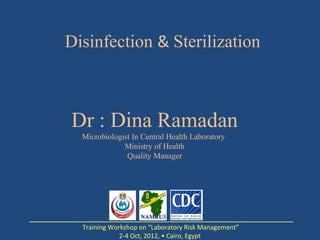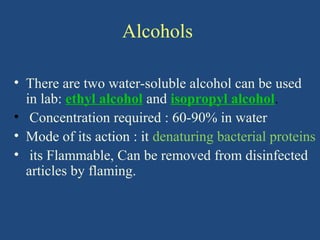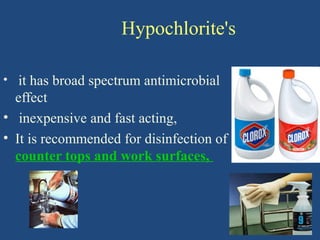Disinfection
- 1. Disinfection & Sterilization Dr : Dina Ramadan Microbiologist In Central Health Laboratory Ministry of Health Quality Manager Training Workshop on “Laboratory Risk Management” 2-4 Oct, 2012, • Cairo, Egypt
- 2. Definitions Disinfection: It is a procedure intended to reduce microorganisms as far as possible (but not bacterial spores) by physical and chemical means Sterilization: the complete removal or destruction of all forms of microbial life including bacterial spores Remember : No absolute assurance that there is 0 microorganism
- 3. Other Definitions Disinfection The use of a physical or chemical procedure to eliminate pathogenic microorganisms on inanimate objects Sterilization The use of a physical or chemical procedure to destroy all microbial life, including large numbers of highly resistant bacterial spores.
- 5. Alcohols • There are two water-soluble alcohol can be used in lab: ethyl alcohol and isopropyl alcohol. • Concentration required : 60-90% in water • Mode of its action : it denaturing bacterial proteins • its Flammable, Can be removed from disinfected articles by flaming.
- 6. Alcohols effect on bacteria • they are bactericidal against for the vegetative forms of bacteria (Gram + and Gram -); • also they are tuberculocidal, fungicidal, and virucidal against enveloped viruses (HIV, influenza ,herpes viruses). • not effective against bacterial spores and have limited effectiveness against nonenveloped viruses ( adenovirus, rotavirus)
- 7. Alcohols • Higher concentrations are less effective as the action of denaturing proteins is inhibited without the presence of water
- 8. Hypochlorite's • it has broad spectrum antimicrobial effect • inexpensive and fast acting, • It is recommended for disinfection of counter tops and work surfaces,
- 9. Chlorine • It is very effective against vegetative bacteria and viruses like HBV and HIV viruses, therefore its use is recommended at 1:10 dilution for disinfection of blood spills • not much useful against spores
- 10. Phenol • It effective against bacteria (especially gram +ve bacteria) and enveloped viruses. • They are not effective against non enveloped viruses and spores. • This compounds is used for decontamination of the hospital environment, including laboratory surfaces.
- 11. No Disinfectant is substitute for the following Procedures • Hand washing (hand hygiene); • use of personal protective equipment (PPE )in the lab • Environmental cleaning • Appropriate handling of waste and • Taking care of yourself (e.g. immunization)
- 12. Yet no substitute for washing hands Do not forget to Wash Your Hands Immediately on arrival at work After handling specimens After removing gloves After using the toilet Before leaving work
- 13. Sterilization 1. Heat sterilization 2. Chemical sterilization 3. Radiation sterilization
- 14. Heat Sterilization It is the simplest, most effective and inexpensive method. Types of heat sterilization : a) Steam sterilization (Autoclaving) b) Dry heat sterilization
- 15. Mechanism of Action • DRY HEAT • MOIST HEAT • protein denaturation 1. Protein denaturation & 1. Oxidative damage coagulation 2. Toxic effects of 2. Latent heat liberated increased levels of when steam condenses on electrolytes cooler surface 3. Hydrolysis & breakdown of bacterial proteins
- 16. Steam Sterilization (MOIST HEAT ) Advantages: – good penetration – maintains integrity of liquids (e.g. Lubricants) due to the 100% humidity within the chamber. Disadvantages: – Non stainless steel metal items corrode – may damage plastic and rubber items
- 17. Dry-Heat Sterilization • Heating at atmospheric pressure and often use a fan to obtain uniform temperature by circulation. • Heat at 180º for half hour , 170º for 1 hr., or 160º C for 2 hrs. Temperature (°C) Time (minutes) 120 480 140 180 150 150 160 120 170 60 180 30
- 18. Dry-Heat Sterilization • Advantages: • It is effective and safe for metal instruments because the process does not dull instrument edges or rust/corrode the instruments. • Disadvantages: – Less reliable than autoclaving – Many materials do not tolerate dry heat (as media)
- 19. Chemical Sterilization • The chemical compounds used can be: a) Gas Sterilization b) Liquid Sterilization • Generally, chemical sterilization procedures have the disadvantages of presenting health hazards to users (e.g. poisonous, flammable, )
- 20. Gas Sterilization • The gas used in this procedure is ethylene oxide. • Keep objects in constant atmospheric humidity. • Heat to temperatures between 30º and 60º C,for a period of 10 hrs. • Residual ethylene oxide must be ventilated • It is used for sterilizing endoscopes and ansthetic apparatus.
- 21. Liquid Sterilization • Can be performed with buffered glutaric aldehyde. • Procedure: – Immerse object in liquid for several hours. – Rinse with sterile water after end of procedure. – It used in hospitals for sterilization of surgical instruments, rubber or plastic equipment which cannot be heat sterilized
- 22. Radiation Sterilization • Provides effective way of sterilization when using non ionizing radiation in high doses (Gamma radiation ). • it is clean process • dry process • the object full exposure from all directions
- 23. Non ionizing radiations • UV RAYS (ultra violet) are used to sterilize internal Surfaces of safety cabinets, entry ways, Operation theaters etc. • IR RAYS ( infra red) are used for rapid mass sterilization of pre packed items such as syringes, catheters etc.
- 24. Sterilizing Filter • Aqueous liquids sterilized by forced passage through filter of porosity small enough to retain any microorganism. 1) Membrane filters: • Manufactured from variety of polymeric material such as cellulose diacetate, polycarbonate and polyester, as disc. • Membrane made in 2 ways I. Labyrinthine pore membranes: Bacteria & yeast II. Capillary pore membranes: For viruses Filters may be supplied with plastic holders pre sterilized for single use, or mounted in re-usable holders and fitted to filtration vessels.
- 25. Sterilizing Filter 2)Syringe filters: • Membrane 13-25mm diameter. • Fitted in syringe like holders of stainless steel or polycarbonate. • Used for sterilization of small volumes of fluid. 3)Vacuum and in- line filters: • Membranes of 25-45 mm diameter are used either with in line filter holders of Teflon or stainless steel and aluminum. • Used for sterilization of large volumes of air and liquid.
- 27. In summary • Sterilization and disinfection are costly and time consuming process • However, it is an essential in all health care facilities to avoid infection. • It depends the material and users of instrument. • Staff should keep in mind that contaminated instrument present risk to the sample as well as the user himself.
- 28. 29




























